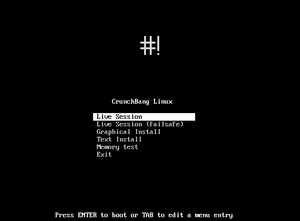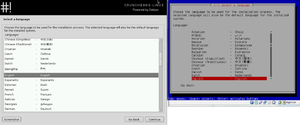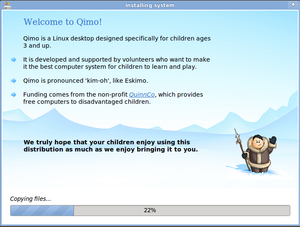COMP 3000 2011 Report: CrunchBang: Difference between revisions
Drewmartin (talk | contribs) |
Drewmartin (talk | contribs) |
||
| Line 2: | Line 2: | ||
== Background == | == Background == | ||
The Linux distribution I chose is [http://crunchbanglinux.org/ CrunchBang] which is commonly referred to as '#!'. CrunchBang is "designed to offer a modern, full-featured GNU/Linux system without sacrificing performance."<ref name="About CrunchBang">About Crunchbang Linux. (2011, Feb. 18). Retrieved October 14, 2011 from http://crunchbanglinux.org/wiki/about</ref> It does not appear to be targeted at any particular audience | The Linux distribution I chose is [http://crunchbanglinux.org/ CrunchBang] which is commonly referred to as '#!'. CrunchBang is "designed to offer a modern, full-featured GNU/Linux system without sacrificing performance."<ref name="About CrunchBang">About Crunchbang Linux. (2011, Feb. 18). Retrieved October 14, 2011 from http://crunchbanglinux.org/wiki/about</ref> It does not appear to be targeted at any particular audience. | ||
CrunchBang was created and continues to be developed by Philip Newborough<ref name="wiki">CrunchBang Linux. (2011, Sep. 26). Retrieved October 14, 2011 from http://en.wikipedia.org/wiki/CrunchBang_Linux</ref> who goes by the name "corenominal" on the [http://crunchbanglinux.org/forums/ CrunchBang forums] and on [http://corenominal.org/ his blog]. No public source code repository could be found and it appears that Philip does all of the development himself. | CrunchBang was created and continues to be developed by Philip Newborough<ref name="wiki">CrunchBang Linux. (2011, Sep. 26). Retrieved October 14, 2011 from http://en.wikipedia.org/wiki/CrunchBang_Linux</ref> who goes by the name "corenominal" on the [http://crunchbanglinux.org/forums/ CrunchBang forums] and on [http://corenominal.org/ his blog]. No public source code repository could be found and it appears that Philip does all of the development himself. | ||
The latest release of CrunchBang, called CrunchBang 10 "Statler" R20110207, is available in 32-bit and 64-bit versions with either the Openbox window manager or the Xfce4 window manager. They are available for download as torrents from the [http://crunchbanglinux.org/downloads/statler/20110207/ CrunchBang downloads page]. The installation CD images are between 640-690MB in size, while a fresh installation of 64-bit CrunchBang took | The latest release of CrunchBang, called CrunchBang 10 "Statler" R20110207, is available in 32-bit and 64-bit versions with either the Openbox window manager or the Xfce4 window manager. They are available for download as torrents from the [http://crunchbanglinux.org/downloads/statler/20110207/ CrunchBang downloads page]. The installation CD images are between 640-690MB in size, while a fresh installation of 64-bit CrunchBang took about 1.7 GB of hard disk space. | ||
CrunchBang is based on Debian GNU/Linux,<ref name="About CrunchBang"/> with the latest release being based on Debian 6.<ref>CrunchBang 10 “Statler” r20110207. (2011, Feb. 8). Retrieved October 14, 2011 from http://crunchbanglinux.org/blog/2011/02/08/crunchbang-10-statler-r20110207/</ref> Previous to this, CrunchBang was based off of Ubuntu releases, up to Ubuntu 9.04.01, but in the latest release Ubuntu was bypassed and it was based straight off of Debian.<ref>Development release: CrunchBang 10 “Statler” Alpha 1. (2010, March 19). Retrieved October 14, 2011 from http://crunchbanglinux.org/blog/2010/03/19/development-release-crunchbang-10-statler-alpha-1/</ref> | CrunchBang is based on Debian GNU/Linux,<ref name="About CrunchBang"/> with the latest release being based on Debian 6.<ref>CrunchBang 10 “Statler” r20110207. (2011, Feb. 8). Retrieved October 14, 2011 from http://crunchbanglinux.org/blog/2011/02/08/crunchbang-10-statler-r20110207/</ref> Previous to this, CrunchBang was based off of Ubuntu releases, up to Ubuntu 9.04.01, but in the latest release Ubuntu was bypassed and it was based straight off of Debian.<ref>Development release: CrunchBang 10 “Statler” Alpha 1. (2010, March 19). Retrieved October 14, 2011 from http://crunchbanglinux.org/blog/2010/03/19/development-release-crunchbang-10-statler-alpha-1/</ref> | ||
| Line 15: | Line 15: | ||
[[File:language.png|thumb|left|Choosing the language in a graphical installation (left) and a text-based installation (right)]] | [[File:language.png|thumb|left|Choosing the language in a graphical installation (left) and a text-based installation (right)]] | ||
I performed both installations from VirtualBox, giving both systems | I performed both installations from VirtualBox, giving both systems identical hardware (16 GB hard disks, 512 MB of memory). Aside from the obvious difference in appearance between the two installation methods, there was no difference in the installation. Both asked for: | ||
* Language | * Language | ||
* Location | * Location | ||
| Line 25: | Line 25: | ||
* Partitioning options | * Partitioning options | ||
[[File:installation.png|thumb|right|Installation progress of the graphical installer (left) and text-based installer (right)]] | |||
The time taken for both installation methods was roughly 10 minutes. | The time taken for both installation methods was roughly 10 minutes. | ||
Revision as of 22:14, 15 October 2011
Part 1
Background
The Linux distribution I chose is CrunchBang which is commonly referred to as '#!'. CrunchBang is "designed to offer a modern, full-featured GNU/Linux system without sacrificing performance."<ref name="About CrunchBang">About Crunchbang Linux. (2011, Feb. 18). Retrieved October 14, 2011 from http://crunchbanglinux.org/wiki/about</ref> It does not appear to be targeted at any particular audience.
CrunchBang was created and continues to be developed by Philip Newborough<ref name="wiki">CrunchBang Linux. (2011, Sep. 26). Retrieved October 14, 2011 from http://en.wikipedia.org/wiki/CrunchBang_Linux</ref> who goes by the name "corenominal" on the CrunchBang forums and on his blog. No public source code repository could be found and it appears that Philip does all of the development himself.
The latest release of CrunchBang, called CrunchBang 10 "Statler" R20110207, is available in 32-bit and 64-bit versions with either the Openbox window manager or the Xfce4 window manager. They are available for download as torrents from the CrunchBang downloads page. The installation CD images are between 640-690MB in size, while a fresh installation of 64-bit CrunchBang took about 1.7 GB of hard disk space.
CrunchBang is based on Debian GNU/Linux,<ref name="About CrunchBang"/> with the latest release being based on Debian 6.<ref>CrunchBang 10 “Statler” r20110207. (2011, Feb. 8). Retrieved October 14, 2011 from http://crunchbanglinux.org/blog/2011/02/08/crunchbang-10-statler-r20110207/</ref> Previous to this, CrunchBang was based off of Ubuntu releases, up to Ubuntu 9.04.01, but in the latest release Ubuntu was bypassed and it was based straight off of Debian.<ref>Development release: CrunchBang 10 “Statler” Alpha 1. (2010, March 19). Retrieved October 14, 2011 from http://crunchbanglinux.org/blog/2010/03/19/development-release-crunchbang-10-statler-alpha-1/</ref>
Installation/Startup

After booting CrunchBang from an installation image, it gives you the option of running it as one of two live sessions, performing a text-based installation, or a graphical installation (as well as running a memory test). As there were two versions of CrunchBang, one using the Openbox window manager, and another using xfce4, I chose to install both, doing the graphical installation for the Openbox version, and text-based for xfce.

I performed both installations from VirtualBox, giving both systems identical hardware (16 GB hard disks, 512 MB of memory). Aside from the obvious difference in appearance between the two installation methods, there was no difference in the installation. Both asked for:
- Language
- Location
- Keyboard configuration
- Host name
- User's full name
- Username and password
- Time zone
- Partitioning options

The time taken for both installation methods was roughly 10 minutes.
Basic Operation
Usage Evaluation
Part 2
Part 3
References
<references />